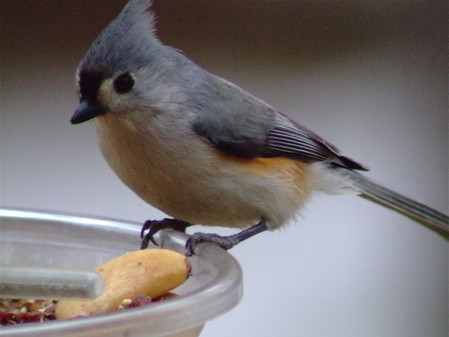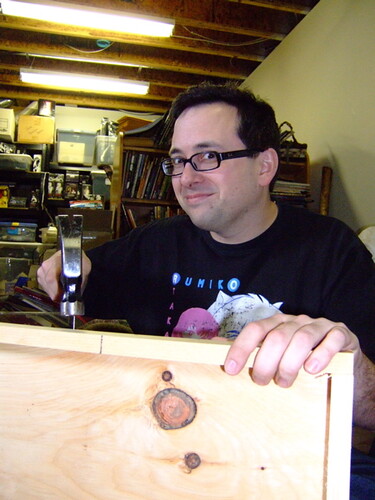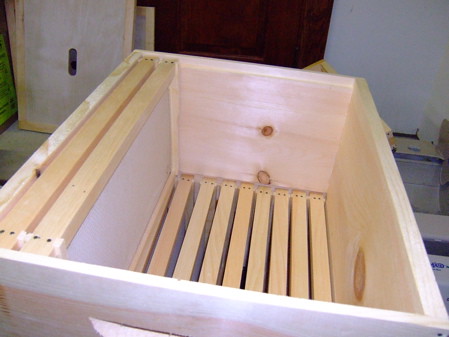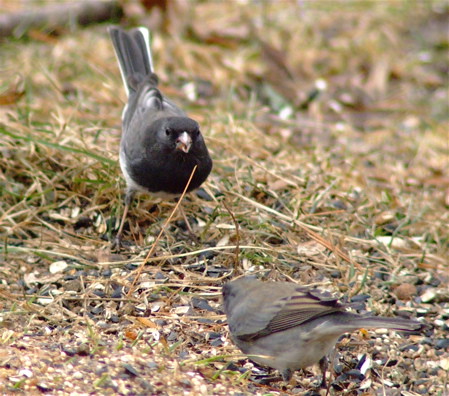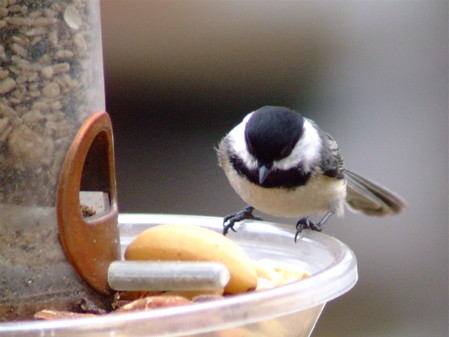Today was the day when I finally got started on realizing my dream of keeping bees. You're really not prepared for that first moment, no matter how many books you have read, videos you have watched, or classes you have taken.
 I stopped at B & B Honey Farms to pick up our two packages of bees. Each package had three pounds of bees inside as well as one queen in her own cage. The queen was put inside her cage and then placed in the box with a bunch of worker bees four days ago. That gives the queen a chance to release all her pheromones to get the workers bonded to her. Or as our beekeeping instructor said, "They work out all their differences."
I stopped at B & B Honey Farms to pick up our two packages of bees. Each package had three pounds of bees inside as well as one queen in her own cage. The queen was put inside her cage and then placed in the box with a bunch of worker bees four days ago. That gives the queen a chance to release all her pheromones to get the workers bonded to her. Or as our beekeeping instructor said, "They work out all their differences."
 I was prepared for the wooden box and having that in my car for two hours as I drove the bees out to Mr. Neil's, but I was not prepared for the "outsiders". There were, of course, escapees at B & B and so those bees just swarmed onto the boxes. They guys loading the bees wiped as many off as they could, but I still ended up driving the whole way back with about a half dozen unsecured bees. I made a deal with them that if they stayed on the box, they could travel in the car, if they wanted to fly around the car, they would go out the window. Only one bee ended up going out the window.
I was prepared for the wooden box and having that in my car for two hours as I drove the bees out to Mr. Neil's, but I was not prepared for the "outsiders". There were, of course, escapees at B & B and so those bees just swarmed onto the boxes. They guys loading the bees wiped as many off as they could, but I still ended up driving the whole way back with about a half dozen unsecured bees. I made a deal with them that if they stayed on the box, they could travel in the car, if they wanted to fly around the car, they would go out the window. Only one bee ended up going out the window.
 I'm proud to say that on the drive back, I only got seriously distracted by birds once. I'm sorry, but you just can't pass a pair of adult eagles sitting in a field so close to the road without trying to take one picture. It was weird, when the car was stopped, you could really hear the humming of the bees.
I'm proud to say that on the drive back, I only got seriously distracted by birds once. I'm sorry, but you just can't pass a pair of adult eagles sitting in a field so close to the road without trying to take one picture. It was weird, when the car was stopped, you could really hear the humming of the bees.
 When I got to the house, Mr. Neil's assistant, Lorraine was there and was ready to document the hiving of the bees. Neil had to leave this morning and was sad to miss it. I was surprised Lorraine was so willing to go along, because she has been quite vocal and very clear that she was in no part going to be the beekeeper in this enterprise. If I'm out at a bird festival and Mr. Neil is out at a book signing and there's a bee emergency, she was not having any part of it. She doesn't like bees. Completely understandable. After all that fuss, I was surprised she wanted to come out with me.
When I got to the house, Mr. Neil's assistant, Lorraine was there and was ready to document the hiving of the bees. Neil had to leave this morning and was sad to miss it. I was surprised Lorraine was so willing to go along, because she has been quite vocal and very clear that she was in no part going to be the beekeeper in this enterprise. If I'm out at a bird festival and Mr. Neil is out at a book signing and there's a bee emergency, she was not having any part of it. She doesn't like bees. Completely understandable. After all that fuss, I was surprised she wanted to come out with me.
The first thing we did was make sure all the hives were ready. They had been placed in the chosen spot, but I did move the two hives further apart (above). When it's time to start taking honey out of your hive, neighboring colonies will try to steal it, so a little space helps with that. And I think a little space makes for healthier neighbors.
 Since having the bees in the car with me for a couple of hours without any mishaps and having watched many videos of smooth hiving of colonies by people not wearing bee suits, I decided that I was going to install our bees without gloves. I was going to wear that hat and net, but not the gloves.
Since having the bees in the car with me for a couple of hours without any mishaps and having watched many videos of smooth hiving of colonies by people not wearing bee suits, I decided that I was going to install our bees without gloves. I was going to wear that hat and net, but not the gloves.
 However, when I got inside the house, I saw that our bee suits had arrived and they looked SO cool (seriously, they looked like astronaut suits...without the built in diaper). I decided that I would wear the bee suit, but not wear the gloves. Lorraine put on a suit too and we both took some gloves with us as we took our bees out to the hives--just in case.
However, when I got inside the house, I saw that our bee suits had arrived and they looked SO cool (seriously, they looked like astronaut suits...without the built in diaper). I decided that I would wear the bee suit, but not wear the gloves. Lorraine put on a suit too and we both took some gloves with us as we took our bees out to the hives--just in case.
 Lorraine had the camera at the ready. I had my hive tool, this was going to be a piece of cake. All I had to do was spray the bees with sugar water, bonk the box so they all went to the bottom, remove the feeder can, remove the queen, scrape off any workers, put the queen in my pocket, spray all the workers with more sugar water, dump them in the hive, take the queen out of my pocket, spray her, open her screen and then have her crawl onto the frames with the workers, put on the feeder pail, the pollen patty, and close up the hive--simple right? I had Lorraine hold on to the instruction book to read each step to me as I went along.
Lorraine had the camera at the ready. I had my hive tool, this was going to be a piece of cake. All I had to do was spray the bees with sugar water, bonk the box so they all went to the bottom, remove the feeder can, remove the queen, scrape off any workers, put the queen in my pocket, spray all the workers with more sugar water, dump them in the hive, take the queen out of my pocket, spray her, open her screen and then have her crawl onto the frames with the workers, put on the feeder pail, the pollen patty, and close up the hive--simple right? I had Lorraine hold on to the instruction book to read each step to me as I went along.
 So, far so good. I sprayed the bees and I bonked the box, they went to the bottom. I pulled out the feeder can--it came out so easy! I was fully expecting it to be stuck in there with some propolis. Out came the can, easy as pie...and then out exploded a few hundred bees.
So, far so good. I sprayed the bees and I bonked the box, they went to the bottom. I pulled out the feeder can--it came out so easy! I was fully expecting it to be stuck in there with some propolis. Out came the can, easy as pie...and then out exploded a few hundred bees.
 With bees, flailing is a no no. They are more likely to sting if you flail. What happens when you remove the feeder can, which you can't really see in the videos (and now that I look at my photos, you really can't see in the photos either) is that many of the bees get confused and fly out.
With bees, flailing is a no no. They are more likely to sting if you flail. What happens when you remove the feeder can, which you can't really see in the videos (and now that I look at my photos, you really can't see in the photos either) is that many of the bees get confused and fly out.
 Have you ever had that feeling on a roller coaster when you get to the crest of the first hill and you just feel this deep, guttural panic and are willing to trade ANYTHING to not be there at that moment to be ANYWHERE else but there. That's pretty much what I felt at the moment the feeder can was removed (that's Lorraine above doing a dramatic reenactment of the moment). I tried to collect myself--I had to get the queen out and get what bees I could into the hive. I sprayed everything with sugar water. Lorraine, sensing my panic kept reading instructions. I pulled out the queen, she was covered in workers, I tried to brush them off, but I could feel their little vibrating bodies on my bare hands and it freaked me out. I started chanting as calmly as I could, "Don't flail. Don't flail. Don't flail." It was pretty much a substitute for the river of obscenities flowing through my brain.
Have you ever had that feeling on a roller coaster when you get to the crest of the first hill and you just feel this deep, guttural panic and are willing to trade ANYTHING to not be there at that moment to be ANYWHERE else but there. That's pretty much what I felt at the moment the feeder can was removed (that's Lorraine above doing a dramatic reenactment of the moment). I tried to collect myself--I had to get the queen out and get what bees I could into the hive. I sprayed everything with sugar water. Lorraine, sensing my panic kept reading instructions. I pulled out the queen, she was covered in workers, I tried to brush them off, but I could feel their little vibrating bodies on my bare hands and it freaked me out. I started chanting as calmly as I could, "Don't flail. Don't flail. Don't flail." It was pretty much a substitute for the river of obscenities flowing through my brain.
 Lorraine just kept reading the instructions over and over in a steady pace, anything to keep our minds off of the massive amounts of bees flying around us and trying to land on us. I got the queen into my pockets and then went to dump the rest of the workers in the hive. "Stay calm." I thought to myself. "Lorraine doesn't like bees, if I panic, it won't help her." I later learned she was thinking the exact same thing, that she needed to keep calm because her freaking out wouldn't help me. I think we saved each other with that bit of logic.
Lorraine just kept reading the instructions over and over in a steady pace, anything to keep our minds off of the massive amounts of bees flying around us and trying to land on us. I got the queen into my pockets and then went to dump the rest of the workers in the hive. "Stay calm." I thought to myself. "Lorraine doesn't like bees, if I panic, it won't help her." I later learned she was thinking the exact same thing, that she needed to keep calm because her freaking out wouldn't help me. I think we saved each other with that bit of logic.
I love the photo above, I can see that I'm trying to keep calm, but underneath I'm really just a freaked out mess--note my little pinky finger in the air as I'm trying to dump the bees in the hive? Yeah, trying to look dainty is really helping.
I bonked and I bonked the box, but I could not get the workers inside the hive, sure a few fell in, but many were flying out as they were being poured in and even more were just staying in the box. They were not pouring and spreading like pizza sauce (which is what is supposed to happen according to the video and the class I took). I kept shaking the box back and forth--they weren't coming out. Some were landing on my hand, startling me and causing me to flail.
Lorraine said in awe, "Oh man, you have SO many bees on you!"
"I don't want to know!" I warned. I finally put the box down and said as calmly as I could, "Okay, we are going to walk away and put gloves on."
Lorraine agreed with the plan.
We put the gloves on and then I tried to get as many bees as I could into the hive. I took the queen out of my pocket, opened her cage, and held it on one of the frames in the hive. She crawled on my hand and finally crawled onto some workers on one of the frames. I turned around to put frames back in the hive but I couldn't find her again. I lost track of her. I assume she is still in there...I hope she is. We'll find out in a week. Many of the workers were drawn to the empty queen cage so I laid that in hive, put in the feeder and the pollen paddy and closed her up. I had to close the entrance to get the bees to stay in the hive for the night and felt a pang of guilt for all the workers now trapped on the outside.
That hive was done, but we still had one more to do. Lorraine and I were both exhausted and decided to head back to the house for some tea and coffee to gird ourselves before the next hiving.
We walked to the house, shell shocked and shedding bees along the way. After removing the feeder, the whole experience was a blank. We pretty much quit taking photos, bees everywhere just freaked us out. I had helped at a beehive before, this was not my first time being around hives, but it was different when it's your own and when you have bare hands.
I was so glad Lorraine was there, we both kept the other from freaking out and running away like a big sissy. Neither one of us got stung with the first installation, but how on earth could we go back and calmly hive the next package? Only time and a cup of tea would tell.
Up next, Part 2: The Hiving of Kitty
 We went out to check on the hives today to make sure that the bees were feeding, had accepted the hive and open the hive entrances. The Kitty hive was in working order. You can see in the above photo that a cluster of bees is on the pollen patty and many more were under the white pail feeding on the nectar. This hive is following the textbook and next week I hope we will find some comb under construction.
We went out to check on the hives today to make sure that the bees were feeding, had accepted the hive and open the hive entrances. The Kitty hive was in working order. You can see in the above photo that a cluster of bees is on the pollen patty and many more were under the white pail feeding on the nectar. This hive is following the textbook and next week I hope we will find some comb under construction. Olga was a different story. No bees feeding at all. We lifted up the nectar pail and no bees were underneath--not good. The pail felt hard and yesterday when we were making nectar, we used some raw sugar to make the nectar for this hive--it had turned into a dry rock. We decided to take the pail back and remake the nectar. The feeding tin that came with the package of bees still had nectar in it, so we placed that in with the bees while we made more. When we came back about forty five minutes later, there were still no bees to be seen--not a good sign. Were they still in the hive? Did they die off?
Olga was a different story. No bees feeding at all. We lifted up the nectar pail and no bees were underneath--not good. The pail felt hard and yesterday when we were making nectar, we used some raw sugar to make the nectar for this hive--it had turned into a dry rock. We decided to take the pail back and remake the nectar. The feeding tin that came with the package of bees still had nectar in it, so we placed that in with the bees while we made more. When we came back about forty five minutes later, there were still no bees to be seen--not a good sign. Were they still in the hive? Did they die off? We moved the frames and within moments one of the workers came up and began sipping the nectar and not long after other workers followed. I'm so glad I took that Beekeeping Short Course at the U of M so I knew what to do! Whew.
We moved the frames and within moments one of the workers came up and began sipping the nectar and not long after other workers followed. I'm so glad I took that Beekeeping Short Course at the U of M so I knew what to do! Whew.

























